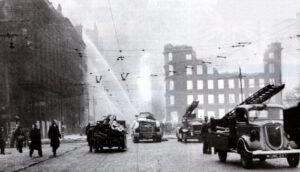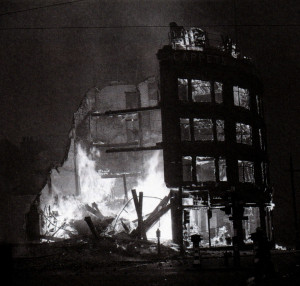
Over two nights in December, 1940, 270 enemy aircraft dropped their deadly cargoes on Manchester.
Incendiaries rained down on the city within minutes of the first sirens at 6.37pm on December 22nd. The follow-up aircraft, loaded with high explosive (HE) bombs, were guided to their targets by the light of these incendiary fires. Within 90 minutes of the first call, every available fire unit in the city was in action, and before the night was over, more than 170 appliances from as far as Cardiff, Birmingham and Newcastle were in attendance.
One of the first bombs fell on the corner of Princess Street and Clarence Street and the building was soon ablaze. Incendiaries set the Royal Exchange and Victoria Buildings alight. On both sides of Miller Street, blocks of warehouses were destroyed. A gas main was gushing fire and within minutes, part of the Victoria Buildings had collapsed into Deansgate, blocking the thoroughfare, with the overhead wires of the tramway system tangled up beneath the rubble. The main roads through the city were blocked by bombs and debris.
It was not long before the sky over Manchester was aglow as one after another, buildings burst into flames.
Scores of famous buildings became mere shells, or disappeared completely.

The devastation might have been prevented had sufficient fire watchers been on duty to douse the sparks and burning embers. Some major landmarks did escape unscathed, including the Town Hall, Central Library and the Midland Hotel. A theory about why this area was saved came from an American Intelligence Officer who claimed to have uncovered papers suggesting Hitler wished to set up his headquarters in the Midland Hotel.
Neighbouring Salford and Stretford were also prime targets for the Luftwaffe -Salford for its docks, which housed Britain’s second largest oil terminal, and Stretford because of its proximity to Trafford Park, where many companies had switched their production to satisfy military needs.
Incendiaries and HE bombs cascaded down on the suburb of Hulme, where my parents lived. They spent the first night of the Blitz in the coal cellar, emerging next morning to find their windows blown out and electricity off, but thankfully the house was intact.
The all-clear was sounded at 6.28am on December 23rd, and by midday every fire in the city was under control. Fire crews spent the rest of the day damping down.
My parents never forgot the destruction they witnessed when they ventured out to check on friends and family. In many streets the houses had their fronts completely ripped off. They passed the partly demolished Hulme Town Hall, where 200 people had been in the shelter when it was hit. Thankfully, they left unharmed through emergency exits.
At 7.15 that evening the Luftwaffe returned. This time their task was made easier with fires still burning from the previous night’s raid. Although the raid proved shorter than the previous night’s (the all-clear was heard at 1.29am) the cumulative effect of the two raids was Buildings burning in Manchester after an air raid on the night of December 23rd, 1940.
devastating. In all there were 1,300 fires in Manchester and the surrounding areas.
Although the fire crews were completely fatigued, they fought with ‘vigour and spirit’ and, an hour after the all-clear, the fires were seemingly under control. Then disaster struck when, without warning, a strong north-east wind sent sparks and burning embers into buildings that had suffered nothing more than broken windows in the bombing. Within half an hour, huge fires raged once again.
The heart of the blaze was in the Piccadilly area. The system of fire stop, whereby fire crews demolished surrounding buildings using explosives, saved the main telephone exchange and electricity works. It was not until the afternoon of Christmas Day that the fires were under control.
Great cost
The cost was enormous. An estimated 684 people were killed and 2,364 injured in Greater Manchester, including 64 members of the emergency services and Civil Defence. A total of 30,000 homes in Manchester and 8,000 in Salford were damaged or destroyed and 5,000 people left homeless.
Within a mile of Albert Square and the Town Hall, 165 warehouses, 150 offices, five banks and more than 200 businesses were destroyed. An estimated 70 per cent of Manchester’s Victorian and Edwardian buildings lay in ruins.
But the city survived, and The Manchester Emergency Committee later reported: ‘The citizens of Manchester suffered the effects of the raids with fortitude and determination of the highest character. At no stage was there any suggestion of panic’.
Manchester remembers…
David Clarke
(www.manchestercathedral.org or 0161 833 2220).








